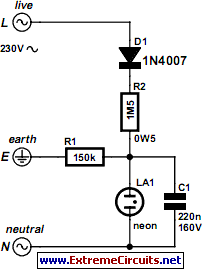Home » Circuits
Earth Fault Indicator
The security of many electrical devices depends today on the availability of an earthed mains outlet. We should remember that these are connected to the frame or to the metal housing of the equipment and so it routes to the protective earth (PE) connections. In this setup, mains voltage, however small, will cause the differential circuit breaker to trip. The circuit breaker is part of any modern electrical installation. This type of security device may however become defective due to common corrosion as we have seen many times on various older household devices, as well as on construction sites.Actually, since these devices are frequently in wet conditions, the screw and/or lug used to connect the earth wire to the device frame corrodes gradually and ends up breaking or causing a faulty contact. The remedy is then worse than the problem because the user, thinking that he/she is protected by earth, does not take special precautions and risks his/her life. However, all that’s needed is an extremely simple system to automatically detect any break in the earth connection; so simple that we ask ourselves why it is not already included as part of all factory production for appliances that carry any such risk, as we have discussed above.
We propose it as a project for you to build using this schematic. The live wire (L) of the mains power supply is connected to diode D1 which ensures simple half-wave rectification which is sufficient for our use. The current which is available is limited to a very low value by resistor R2. If the appliance earth connection to which our circuit is installed is efficient, this current is directed to earth via resistor R1 and the rest of the circuit is inactive due to insufficient power. If the earth connection is disconnected, the current supplied by D1 and R2 charges up capacitor C1.
Circuit diagram:
When the voltage at the terminals of the capacitor reaches about 60 volts, neon indicator light La1 is turned on and emits a flashing light which discharges capacitor C1 at the same time. This phenomenon is reproduced indefinitely as long as the earth connection has not been restored, and the neon light continues to flash to attract attention in case of danger. Building the project is not particularly difficult but, since it is a project aimed at human safety, we must take the maximum of precautions concerning the choice of components utilised. Therefore, C1 must have an operating voltage of at least 160 volts while R2 must be a 0.5-watt resistor, not for reasons of power dissipation, but in order to maintain the voltage.
The neon light can be any type, possibly used, or it may be part of an indicator light to make it easier to attach to the protected appliance. In the second case, we must obviously get rid of its series resistor which would prevent proper operation here. During installation of the circuit in the appliance to be protected, we should also clearly mark Live (L) and Neutral (N) (for example, seek Live with a simple screwdriver) because inverting these two wires at this point will disable proper operation. The final point, which is self-evident considering the principle used here: the earth connection for our setup must be hooked up to the frame of the appliance to be protected at a different point than where the normal earth wire is connected.
Author: Christian Tavernier - Copyright: Elektor Electronic Magazine

